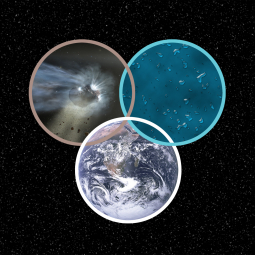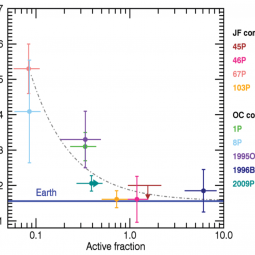By Darek Lis, Dominique Bockelée-Morvan, and Rolf Güsten
Paper:
Terrestrial deuterium-to-hydrogen ratio in water in hyperactive comets
Lis et al., A&A 625, L5 (2019) doi:10.1051/0004-6361/201935554
One of the key questions for modern astrophysics and planetary science concerns the development of the conditions of habitability in planetary systems, such as the early protosolar nebula. Water is an essential ingredient for carbon-based life as we know it. However, the source of terrestrial water is still unknown. In the standard model of the protosolar nebula, the temperature in the terrestrial planet-forming zone was too high for water ice to survive. Consequently, the Earth accreted dry and the present-day water had to be delivered in a later phase, together with organics, by external sources such as comets or asteroids.
Comets are the most primitive volatile-rich bodies in the solar system. The deuterium to hydrogen isotopic ratio in cometary water (the D/H ratio) has been shown to vary between one- and three-times the Earth’s oceans value, in both Oort cloud comets and Jupiter-family comets originating from the Kuiper belt. This has been taken as evidence that comets contributed a relatively small fraction of the terrestrial water. New sensitive spectroscopic observations of water in the Jupiter-family comet 46P/Wirtanen, carried out using the GREAT spectrometer aboard SOFIA, give the same D/H ratio as in the Earth’s oceans. Although the statistics are limited, interesting trends are already becoming apparent in the existing data. A striking anti-correlation is seen between the D/H ratio in water and the active fraction, defined as the ratio of the active surface area to the total nucleus surface (see figure 2). Hyperactive comets with high active fractions, such as 46P/Wirtanen, typically have D/H ratios in water consistent with the terrestrial value. These comets require an additional source of water vapor in their coma, explained by the presence of subliming icy grains expelled from the nucleus.
The observed anti-correlation may suggest that hyperactive comets belong to a population of ice-rich objects that formed just outside the snow line, or in the outermost regions of the solar nebula, from water thermally reprocessed in the inner disk that was transported outward during the early disk evolution. However, based on a large comet sample, hyperactivity is only observed for small comet nuclei. This seems to argue against the first interpretation, as planetesimals near the snow line are expected to undergo rapid growth. Alternatively, isotopic properties of water outgassed from the nucleus and icy grains may be different due to fractionation effects at sublimation. In this case, all comets may share the same Earth-like D/H ratio in water, with profound implications for the early solar system and the origin of the Earth’s oceans.
Enlarging the number of accurate D/H measurements in both Jupiter-family and Oort cloud comets is of paramount importance for understanding the origin of the Earth’s water. Such measurements, carried out at submillimeter, infrared, or UV wavelengths, are challenging from the ground, leading to large observational uncertainties. SOFIA, with its newly upgraded GREAT instrument, can play a key role in this endeavor, critical for understanding planetary habitability.

